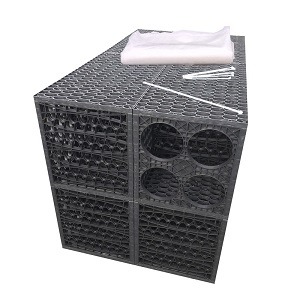How To Avoid A Blocked Soakaway

A soakaway is a system in which a hole has been dug in the ground, filled with a material or a soakaway crate which allows surface water to percolate back into the earth close to where it falls. Although other materials can be used to fill the soakaway holes, soakaway crates are now a more favoured option as they are lightweight with a high void ratio that can be used in residential, commercial, industrial and retail applications.
Identifying a Blocked Soakaway
The most obvious signs of a blocked soakaway will be apparent near the location of the soakaway itself. There may be dips in the ground or waterlogging, or there may be water pollution nearby. In extreme circumstances the rainwater pipes or channel drains that feed into the soakaway may back up and overflow.
Unfortunately if the soakaway does become blocked the best solution is to dig it out and replace it, noting the precautionary steps that we detail below.
Reasons for a Blocked Soakaway
It can be hard to tell exactly what has caused your blocked soakaway, but these are the three most common reasons:
- A build up of silt within the soakaway
- Compacted soil above and around the soakaway.
- A collapse in the pipes feeding the soakaway causing a disruption in the flow of rainwater.
Precautions for avoiding a Blocked Soakaway
The best way to avoid issues with your soakaway is to install it correctly in the first place. This may sound like an obvious statement to make but a correctly specified and installed soakaway constructed from modern crates should last for many years with the need for only a minimal amount of maintenance.

- Use the right type of soakaway crate. Install a suitable commercial or domestic crate dependent on your needs.
- Always wrap the crates in non-woven geotextile membrane. This is essential for any soakaway as it stops any soil or sand particles from being washed into the soakaway system from the surrounding soil, whilst allowing a full flow of rainwater. Be sure to tape or clamp the geotextile carefully around the pipe entry point.
- Make sure you use the correct base, side fill and back fill, as it is these elements that protect the structure from movement in the ground above and around the soakaway. Our product pages all include drawings with these details on, but for a quick rule of thumb domestic soakaways should have a 150mm sharp sand base, 150mm of sand or pea shingle for the side and top fill and a further 150mm to 350mm of soil top fill above the sand/gravel layer depending on whether the soakaway is sited in a garden or under a driveway.
- As an extra precaution, fit a pre-filter. Our Sentinel silt traps are a 600mm deep chamber that incorporate a removable silt bucket made from a sturdy mesh inside a PVC frame. These traps are installed inline in the 110mm drainage pipe that feeds into the soakaway. They catch any mud, silt or dirt particles that are washed into the drain from the gutters, channel drains or land drains that feed into the soakaway. Maintenance is a just a case of removing the lid every three months or so and lifting out and emptying the silt bucket, then replacing it. The silt bucket even comes with a useful high handle attached to avoid the need to reach into the muddy water.
Follow these simple steps and you will be rewarded with a soakaway that works efficiently for a good many years.
If you require any further information about soakaway systems, please take a look at our guides and tips section, with topics covering installation, maintenance and much more besides.


